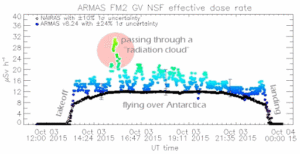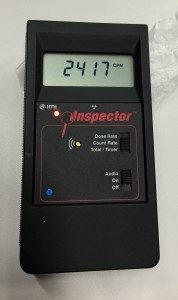Interesting article on hot spots at aviation altitudes published by Space Weather. Anyone who has traveled with a geiger counter on an airplane knows cosmic radiation intensifies at higher altitudes. This article explores that phenomena.
Comments closedCategory: Data
I am in Fukushima today, in the City of Koriyama for a Safecast Conference.
I have traveled here with Safecast people, who have been monitoring the environment for radiation contamination, and posting the data on the internet since 3.11.
When you say 3.11 here, everyone knows what you mean, like 9.11 in the U.S.
The map here shows radiation data I collected on the train from Tokyo to Koriyama. The levels were comparable with what is normal in California.
Iʻve written a lot about Safecast before. A lot more can be easily found on the web.
Itʻs 4 years and 12 visits to Japan since I was first nvited – to help provide technical assistance after 3.11. The whole experience is a big story, not really condensable by me into a blog post. It has involved a lot of hard work and stress and lack of sleep by a lot of people. It has also been incredibly enriching. The people who have shown up to help here are really exceptional. I think about what that means. Ordinary people become exceptional when they show up to help their fellow human beings and the environment. And this group is also very intelligent and technically proficient – and has really fully utilized the power of the internet to respond rapidly.
The people who chose to stay in Fukushima are working hard to recover and make the best of their lives. Fukushima, I am told, means Happy Island, or Lucky Place. I guess they are indeed lucky, in that (given the scale of the triple disaster) things could have gotten much worse. Itʻs important to know that Fukushima is a large prefecture, and only parts of it are contaminated.
Safecast has worked hard for the people of Fukushima and Fukushima people have developed skills and technology to cope with 3.11 aftermath. Now they are talking about being ready to help others if a disaster should occur somewhere else in the world.
Professor Kyoshi Kurukowa is with us and speaking on the stage to a large audience as I write this. Kurukowa – San was asked by the Government of Japan to report on the Fukushima Daiichi event – to the Japanese Diet. His report said a lot worth paying attention to. Heʻs a wise man.
One thing he said in the report that sticks with me was that the nuclear accident was man made and preventable. Not that the earthquake and tsunami was not a huge deal. But that information that this could happen existed, and the appropriate actions, upgrades and repairs were put off until it was too late.
Dr. Kurukowa is finishing his presentation now, and ends his talk with: “Think about what you can do for the next generations, and do what you can for them.”
Iʻm sure Safecast will post more about this conference at http://www.safecast.org.
The image at left is a reading with a Geiger Counter on a sample of soil under a downspout outside the conference center here. It shows that, while great progress has been made, clean up will be ongoing. The conference center itself and parking lot
did not show unusual levels of radioactivity.
Comments closedOpinions expressed in this article reflect only the authorʻs viewpoint.
Earlier blogposts here identified elevated radiation levels at Surferʻs Beach in Half Moon Bay as “not from Fukushima.” After a trip to the site and further analysis, I stand by that conclusion. I will publish more on that here soon. I hope this alleviates concern across the Pacific Rim, because it should.
Independent Safecast has put together a compilation of information on Fukushima Daiichi impacts on the ocean here.
California State Office of Emergency Services (CalOES) has informed me that California Department of Public Health (CDPH) is doing further testing on samples taken from Half Moon Bay. They will post the results here.
I applaud CDPH for taking a precautionary approach.
I think this is a good idea for a number of reasons. Most importantly, it will help build trust that this beautiful beach is a safe place for children. I have requested further details of the nature of the testing.
I hope that a full chemical and spectral analysis will be done to determine without doubt that these naturally occurring radionuclides are native to this beach and not introduced.
Part of my cautious approach to this is the public knowledge that radioactive materials were dumped at the Farallon Islands, approximately 35 miles offshore from Half Moon Bay. There are also other sites in the Bay Area contaminated with TENORM materials, notably Treasure Island and Hunterʻs Point.
Further testing will help build public confidence that California is a place where transparency thrives, where our public officials are proactive in protecting the public health, and where our beaches are safe. I hope and expect that will be the conclusion, and again thank CDPH for further testing.
CalOES asked me to post this message:
“There is no public health risk at California beaches due to radioactivity related to events at Fukushima . The California Department of Public Health (CDPH) is not aware of any recent activity at Fukushima, or any new data that would cause elevated radioactivity on California shores from the Fukushima incident. Recent tests by the San Mateo County public health department and CDPH show that elevated levels of radiation at Half Moon Bay are due to naturally occurring materials and not radioactivity associated with the Fukushima incident.
The volume of water in the Pacific Ocean has a significant diluting effect on radionuclides that are present and it is not anticipated that the concentration will increase in the waters off of the west coast. CDPH has collected and will be analyzing sand samples from Half Moon Bay. Results of the analysis will be posted on the CDPH Radiologic Health (RHB) website (http://www.cdph.ca.gov/programs/Pages/RHB-RadReport.aspx) as soon as the analysis is completed.”
Other information:
CDPH also performs routine air and milk samples as required by California law. Slightly elevated air and milk samples were found during the initial phases of the Fukushima incident (March 2011) and the results were reported on CDPH RHB’s website (see link above). CDPH continues to monitor air, milk, kelp, and fish samples. CDPH’s monitoring is part of its on-going environmental monitoring program and will be publishing data on the CDPH RHB website by the end of this week.
CDPH has been in contact with the U.S. Nuclear Regulatory Commission (NRC) and they are monitoring the situation with the nuclear reactors in Japan. The FDA as well as the private entity Woods- Hole Oceanographic Institution (WHOI) have monitored fish from the Pacific and while minute levels of cesium were found in blue fin tuna most recent tests show even those small levels are declining. The United States Environmental Protection Agency (USEPA) is the coordinating Agency for response to international emergencies involving radioactive materials and the FDA is responsible for food safety. FDA’s hotline number is 888-723-3366. The USEPA, via their RadNet system, monitors the nation’s air, drinking water, precipitation, and pasteurized milk to determine levels of radiation in the environment. RadNet sample analyses and monitoring results provide baseline data on background levels of radiation in the environment and can detect increased radiation from radiological incidents, such as the Fukushima incident. You may visit the USEPA RadNet website at http://www.epa.gov/radnet/ and this site has a link regarding public questions.
Some additional useful links:
The National Oceanographic and Atmospheric Administration (NOAA) addresses threats to coastal areas. You can see information about their tracking of debris from Japan at:
http://marinedebris.noaa.gov/tsunamidebris/
The International Atomic Energy Agency (IAEA) provides publically available reports on leakage and sea water radioactivity near the Fukushima Daiichi plant. The last report can be found at: http://www.iaea.org/newscenter/news/2013/japan-basic-policy6.html
The state of Oregon continues to test drinking water, rain water and sea water for radionuclides that could be associated with Fukushima.
Comments closed



